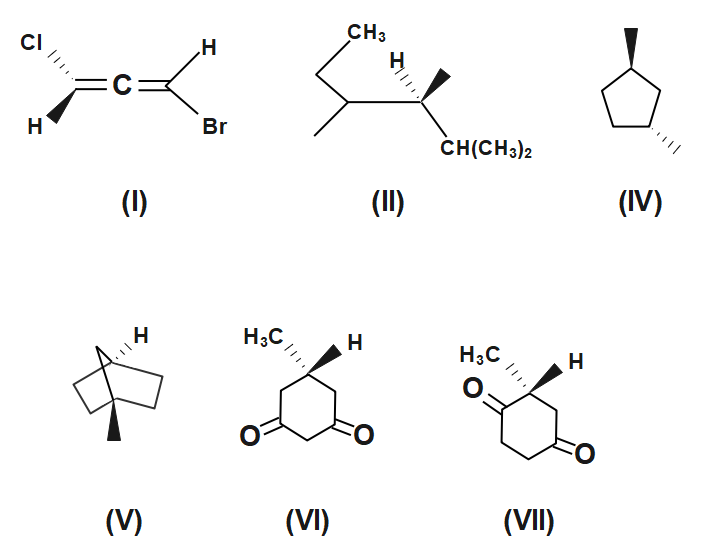
Which of the following molecules is (are) chiral?

(A) I and II
(B) III and IV
(C) II, IV and VI
(D) I, II, III and VI

Answer
428.7k+ views
Hint: In order to understand chirality and stereoisomers, one must understand the concept of spatial arrangement. Spatial arrangement of atoms means how different t atomic particles and molecules are situated in the space around the organic compound, namely its carbon chain. In this sense, the spatial arrangement of an organic molecule is different; the atomic particles and molecules are situated in the space around the organic compound, namely its carbon chain. In this sense, the spatial arrangement of an organic molecule is dimensional direction by even one degree.
Complete step by step solution:
Chirality means 'mirror-image, non-superimposable molecules', and we can say that a molecule is chiral if its mirror image (it must have one) is not the same as itself. A carbon atom that is bonded to four different, atoms or groups loses all symmetry, and is often referred to as an asymmetric carbon. The configuration of such a molecular unit is called a chiral, and the structure may exist in either a right-handed configuration or a left handed configuration.
In compound I all the C-atoms are symmetric ,so no carbon atom is chiral.
In compound II all the C-atoms are symmetric ,so no carbon atom is chiral.
In compound III all the C-atoms are symmetric ,so no carbon atom is chiral.
In compound IV all the C-atoms are symmetric ,so no carbon atom is chiral.
In compound V groups attached are the same .Hence it is also achiral.
In compound VI groups attached are the same .Hence it is also achiral.
Therefore, compound I, II, III and IV are chiral, i.e. option D is the correct answer.
Note:
A useful step in examining structural formulas to determine whether stereoisomers may exist is to identify all stereo genic elements. A stereo genic element is a center, axis or plane that is a focus of stereoisomerism, such that an interchange of two groups attached to this feature leads to a stereoisomer. Stereogenic elements may be chiral or achiral. An asymmetric carbon is often a chiral stereo genic center, since interchanging any two substituent groups converts one enantiomer to the other.
Complete step by step solution:
Chirality means 'mirror-image, non-superimposable molecules', and we can say that a molecule is chiral if its mirror image (it must have one) is not the same as itself. A carbon atom that is bonded to four different, atoms or groups loses all symmetry, and is often referred to as an asymmetric carbon. The configuration of such a molecular unit is called a chiral, and the structure may exist in either a right-handed configuration or a left handed configuration.
In compound I all the C-atoms are symmetric ,so no carbon atom is chiral.
In compound II all the C-atoms are symmetric ,so no carbon atom is chiral.
In compound III all the C-atoms are symmetric ,so no carbon atom is chiral.
In compound IV all the C-atoms are symmetric ,so no carbon atom is chiral.
In compound V groups attached are the same .Hence it is also achiral.
In compound VI groups attached are the same .Hence it is also achiral.
Therefore, compound I, II, III and IV are chiral, i.e. option D is the correct answer.
Note:
A useful step in examining structural formulas to determine whether stereoisomers may exist is to identify all stereo genic elements. A stereo genic element is a center, axis or plane that is a focus of stereoisomerism, such that an interchange of two groups attached to this feature leads to a stereoisomer. Stereogenic elements may be chiral or achiral. An asymmetric carbon is often a chiral stereo genic center, since interchanging any two substituent groups converts one enantiomer to the other.
Recently Updated Pages
Master Class 11 Accountancy: Engaging Questions & Answers for Success

Express the following as a fraction and simplify a class 7 maths CBSE

The length and width of a rectangle are in ratio of class 7 maths CBSE

The ratio of the income to the expenditure of a family class 7 maths CBSE

How do you write 025 million in scientific notatio class 7 maths CBSE

How do you convert 295 meters per second to kilometers class 7 maths CBSE

Trending doubts
Which are the Top 10 Largest Countries of the World?

Differentiate between homogeneous and heterogeneous class 12 chemistry CBSE

What is a transformer Explain the principle construction class 12 physics CBSE

Draw a labelled sketch of the human eye class 12 physics CBSE

What is the Full Form of PVC, PET, HDPE, LDPE, PP and PS ?

How much time does it take to bleed after eating p class 12 biology CBSE




